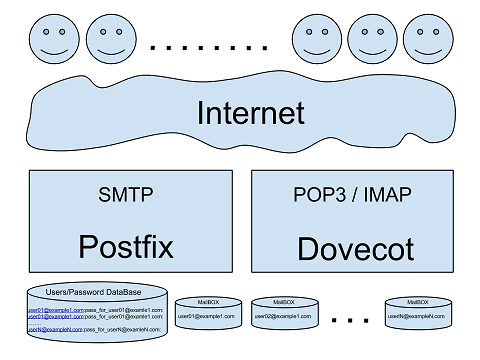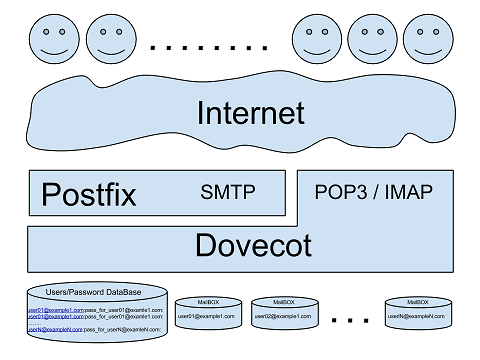Minimal mail server based on Postfix and Dovecot. Part 1: Dovecot
Objective: get a minimally working mail server using only Postfix and Dovecot, with minimal changes to the default settings. Get the skeleton of the system, based on which you can, in the future, configure spam filters, work with databases, LDAP ...
The mail system should:
Setup was carried out in CentOS 6. Postfix 2.6.6, Dovecot 2.0.9. No OS features applied.
Conventionally, mail systems can be divided according to the method of access to mailboxes and the list of users.
The main advantages of the classical system compared to the simplified:
The main disadvantages of the classical system compared with the simplified:
Despite the fact that Dovecot is a core system that performs many functions. Its setup should not cause any difficulties. Perhaps this is due to the fact that Dovecot only deals with authenticated clients, which is not the case with Postfix. Names will be set in the format username @ domainname.
Now it is enough to add user names and passwords to the / etc / dovecot / users file, and mailboxes will be created automatically after the first successful user authentication. Or, looking ahead, after the user receives the letter.
Part 2: Postfix .
The mail system should:
- Maintain any number of domains and users.
- Serve users who are not tied to local accounts.
- Provide access to mailboxes via POP3, IMAP protocols with TLS support.
- To provide sending and reception of letters via SMTP protocol with TLS support.
Setup was carried out in CentOS 6. Postfix 2.6.6, Dovecot 2.0.9. No OS features applied.
The structure of the postal system
Conventionally, mail systems can be divided according to the method of access to mailboxes and the list of users.
The main advantages of the classical system compared to the simplified:
- Performance. Postfix has access to mailboxes and can be faster and easier than in the second case, to deliver mail directly to the user.
- Independence of system parts from each other. In case Dovecot is disabled, Postfix will continue its main function - to receive letters.
The main disadvantages of the classical system compared with the simplified:
- Mailbox format should be understandable to both programs.
- It is necessary to synchronize access to mailboxes.
- Security. Additional permissions are required for Postfix. Postfix should have direct access to mailboxes and the list of users.
- Setup and maintenance is a bit more complicated.
Dovecot
Despite the fact that Dovecot is a core system that performs many functions. Its setup should not cause any difficulties. Perhaps this is due to the fact that Dovecot only deals with authenticated clients, which is not the case with Postfix. Names will be set in the format username @ domainname.
- Create a user "vmail" to store mail, without the "shell" of access, but with the home folder "/ home / vmail".
- Configure authentication.
(login is the same plain but for Outlook)auth_mechanisms = plain login
Restricting the transfer of a password only after establishing a TLS connection is performed in Dovecot by default and does not require additional settings. Since we will use TLS, we do not need any other authentication mechanisms, only PLAIN. The self-signed certificate, in CentOS, is created when Dovecot is installed in the / etc / pki / dovecot / certs / folder, we will use it for now to configure TLS.mail_gid = vmail mail_uid = vmail
I want to draw your attention to one important point. It is necessary to distinguish the authentication mechanism from the method of storing the authentication data. Although these two concepts may be called the same, they are two different things. Details here and here . - Set up where we will store user mailboxes.
For each virtual user, set the home folder in the format - / home / vmail / domain / username,
and the location of mail in the home folder is / home / vmail / domain / username / Maildir,mail_home = /home/vmail/%d/%n
Maildir format Maildir is chosen to simplify the transition to the classical system, if necessary, because Postfix supports Maildir. But if you do not plan to return to the classic system, you can choose any mailbox format supported by Dovecot .mail_location = maildir:~/Maildir
') - The following two directives specify where and how Dovecot will look for user names and passwords.
userdb { args = username_format=%u /etc/dovecot/users driver = passwd-file } passdb { args = scheme=ssha512 username_format=%u /etc/dovecot/users driver = passwd-file }
Sample password file (password cut off):user1@example1.com:{SSHA512}2YT51xuhilbvb4vYRIb1oj1EvrKFszhf2MNw=:::::: user3@example3.com:{SSHA512}GdBv9GEE1rfFpd4+fzXS+UKh4x6gTpTaH4=::::::#!/bin/sh echo $1:$(doveadm pw -s ssha512 -p $2):::::: >> /etc/dovecot/users - Let's configure services for communication with Postfix.
To search for usernames and SASL authentication.service auth { unix_listener /var/spool/postfix/private/auth { group = postfix mode = 0660 user = postfix } unix_listener auth-userdb { mode = 0600 user = vmail } }service lmtp { unix_listener /var/spool/postfix/private/dovecot-lmtp { group = postfix mode = 0600 user = postfix } user = vmail } protocol lmtp { postmaster_address = postmaster@example1.ru }
Summary “devconf –N”:
# 2.0.9: /etc/dovecot/dovecot.conf # OS: Linux 2.6.32-504.16.2.el6.x86_64 x86_64 CentOS release 6.6 (Final) auth_mechanisms = plain login mail_gid = vmail mail_home = /home/vmail/%d/%n mail_location = maildir:~/Maildir mail_uid = vmail mbox_write_locks = fcntl passdb { args = scheme=ssha512 username_format=%u /etc/dovecot/users driver = passwd-file } service auth { unix_listener /var/spool/postfix/private/auth { group = postfix mode = 0660 user = postfix } unix_listener auth-userdb { mode = 0600 user = vmail } } service lmtp { unix_listener /var/spool/postfix/private/dovecot-lmtp { group = postfix mode = 0600 user = postfix } user = vmail } ssl_cert = </etc/pki/dovecot/certs/dovecot.pem ssl_key = </etc/pki/dovecot/private/dovecot.pem userdb { args = username_format=%u /etc/dovecot/users driver = passwd-file } protocol lmtp { postmaster_address = postmaster@example.com } Now it is enough to add user names and passwords to the / etc / dovecot / users file, and mailboxes will be created automatically after the first successful user authentication. Or, looking ahead, after the user receives the letter.
Part 2: Postfix .
Source: https://habr.com/ru/post/258279/
All Articles

